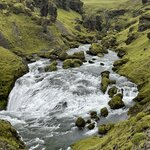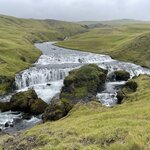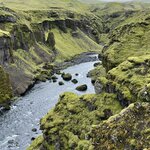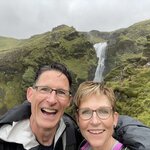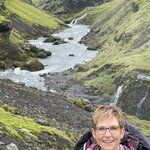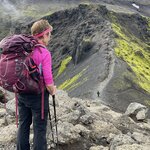While Iceland has no shortage of beautiful places to visit, the country's southern regions are undeniably its most popular. During the high season, finding parking at hotspots like Skogafoss Falls or the Geysir geothermal area can be brutal, and the famous Blue Lagoon now hosts more than 1 million visitors each year.
The good news? There are plenty of other waterfalls, lagoons, volcanoes, black sand beaches, and glaciers that serve as perfect alternatives to the traditional list-toppers. Get off the tourist trail, and you'll not only secure yourself some solitude—you'll also help reduce the environmental impact that takes a toll in Iceland's most beloved areas.
Instead of Seljalandsfoss, Visit Svartifoss Waterfall

Tourists flock to Seljalandsfoss Falls, located just off the Ring Road, to access its one-of-a-kind view via a walking path behind the curtain of falling water. This feature makes it one of the most visited waterfalls in Iceland—and one of the most photographed. On any given day, the area is packed with people (and tripods).
Shutter-happy travelers looking for a more unique shot can head to Svartifoss instead. Located in the majestic Skaftafell region, part of Vatnajökull National Park in the south, this 85-foot cascade is surrounded on all sides by fantastical lava columns resembling organ pipes. To get to the waterfall, you’ll have to hike for about a mile from the Visitor Center in Skaftafell, but the walk is anything but boring and you'll come across a few other waterfalls along the way.
Instead of Geysir, Visit the Hverir Geothermal Area

It’s easy to see why the Geysir geothermal area has become a favorite stop along the Golden Circle. It's home to Strokkur, an active geyser that spews hot water 100 feet into the air every few minutes, and a few other (less dramatic) hot springs all concentrated within a walkable distance.
If its geothermal activity you're after, skip Geyser and head to Hverir. Not far from Lake Mývatn along the Diamond Circle driving loop in northeast Iceland, Hverir's reddish soil is cracked and steaming, pierced with pools of boiling mud and hot springs. It will seem like you’ve traveled to Mars—and Game of Thrones fans may feel like they're in an episode (the location was featured in the show—here are a few more spots in Iceland that fans should check out).
Since the ground temperature reaches about 400 degrees Fahrenheit, it's not advisable to venture beyond the roped paths. If you're a good hiker, go up the hill along the marked trail to the top of Námafjall mountain. It will take you about an hour along the steep-at-times terrain to reach the summit, but the views over Hverir are worth the sweat.
Instead of The Blue Lagoon, Visit Myvatn Nature Baths

The Blue Lagoon is a 94,000 square-foot complex, featuring a gigantic hot pool, hotel, modern spa, and restaurant. It hosts more than a million people each year who come to take a dip in its milky blue waters, known to have relaxing (and some say healing) properties.
But the North of Iceland has a "blue lagoon" of its own that feels a lot more private. The Mývatn Nature Baths make for a perfect respite after a long drive through the highlands. The quiet complex has two steam rooms, the requisite hot pools, and a cooler pool with lava field views. Similar to the Blue Lagoon, the water temperature hovers around 100 degrees Fahrenheit and is rich in alkaline. For lunch, you can try hverabraud (hot spring bread) with smoked trout—the bread is prepared in ovens built into the ground and baked using geothermal heat.
The Mývatn Nature Baths are located about 302 miles from Reykjavik, in the Mývatn Nature Reserve, famous for several must-see sights including its beautiful namesake lake and the mysterious Grotagja Lava Cave. Read more about the area in this article (and check out more of Iceland's best hot pools here).
Instead of Jökulsárlón, Visit Fjallsárlón Glacier Lagoon

Jökulsárlón glacial lagoon in Vatnajökull National Park is known for its otherworldly landscape: steely blue waters pierced by huge chunks of ice. The shoreline nearby is appropriately named Diamond Beach, for the countless ice blocks dotting the black sand.
Unsurprisingly, tourists and photographers are a constant at Jökulsárlón—but travel only six miles west, and you'll come across an equally beautiful glacial lagoon. While Fjallsárlón is much smaller than Jökulsárlón, its diminutive size allows for views of the entire lagoon, from the coast to where icebergs break off from the glacier and fall into its waters. Access to the lagoon is easy from Route 1, and there is also a parking lot on site. Pro tip: you can even book a boat tour of Fjallsárlón and see the icebergs from up close, just like at neighboring Jökulsárlón.
Instead of Gullfoss Falls, Visit Dettifoss

The Golden Circle may be home to Iceland's iconic Gullfoss Falls, but the northeastern Diamond Circle has its own claim to fame: Dettifoss, Europe’s most powerful waterfall, one of three cascades located at the southern end of Jokulsarglijufur National Park. Playfully referred to as “the Beast,” Dettifoss is 145 feet tall and 328 feet wide, with 176 tons of water per second plunging over its edge. You can hear the waterfall’s rumble from half a mile away.
Visitors can actually walk to a spot at the edge of the waterfall (just like Ridley Scott’s character did in the opening scene of the 2012 film Prometheus). If you're not interested in that level of thrill, there are also marked paths around the waterfall that lead to equally satisfying viewpoints. There are two roads that lead to Dettifoss, one on each side of the canyon, and both the east and west banks have parking lots.
Jokulsargljufur National Park is a huge natural area notable for the aforementioned waterfalls, Hljóðaklettar and Rauðhólar in the center, Asbyrgi Canyon to the north, and lots of excellent hiking throughout. Read more about it here.
Instead of Skogafoss Falls, Visit Goðafoss

Crowds aren't just a bother to fellow travelers—they can be detrimental to the environment, too. The heavy foot traffic around beloved Skogafoss Falls, located just off Route 1, led to temporary closure of one of the frequented walking paths above the cascade in an effort to preserve the fragile vegetation.
Reduce your impact and head instead to one of the most spectacular waterfalls in the north: Goðafoss. This horseshoe-shaped waterfall is only 38 feet high, but about three times as wide—and it's approachable from both the east and west sides, offering a variety of vantage points. There is a large parking lot on the west side (where most of the traffic is) and a smaller one on the east that tends to be less visited. There is also a footbridge connecting both sides, and you could walk down to the base of the waterfall for yet another view.
Goðafoss is located just 32 miles east of Akureyri, the capital of North Iceland. No bigger than most small towns, it's affectionately known as "Iceland's second city" and offers plenty in the way of history, art, nature, and quality cafés and restaurants. For more on Akureyri, check out this article.
Instead of Reynisfjara Beach, Visit the Reykjanes Peninsula Coast

You’ve probably seen the photos: towering cliffs over a strip of black sand, with wondrous lava formations peeking out of the sea in the background. Reynisfjara Beach has developed a reputation as a must-see spot for its eerie, highly instagrammable landscape. Located near the fishing village of Vik (itself worth a visit), Reynisfjara is about 3 hours south of Reykjavik and one of the most popular stops on Route 1.
Cut down on drive time and enjoy a bit more solitude by opting for the Reykjanes Peninsula instead. There are a number of beaches on the peninsular coast that rival Reynisfjara in beauty, and there are many other points of interest along the way. Reykjanesviti Lighthouse, the first lighthouse in Iceland, is a dramatic sight: it looms from Bæjarfell Hill over imposing cliffs, a beautiful beach, and clouds of geothermal steam. You'll also want to head to Brimketill, a natural pool carved by waves beating against lava rock at the ocean's edge. The cliffs of Hafnarberg are also worth a look, and bring your binoculars: located just south of town Hafnir, the area is home to many different species of sea birds.
Continue on east along Route 427 and the entire coast is dotted with stretches of black sand, rugged cliffs, and lava formations. You’ll eventually reach Strandakirkja, a church first built in the12th century by seamen who safely found their way to the coast in a storm. When you're ready for lunch, stop at Bryggjan Café in the fishing town of Grindavík for a hot bowl of soup and lovely harbor views.

